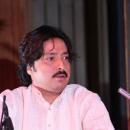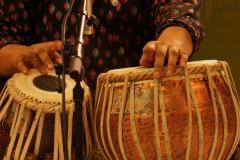The tabla is a South Asian membranophone percussion instrument (like bongos) comprising of a pair of little drums. It has been an especially vital instrument in Hindustani classical music since the eighteenth century, and stays being used in India, Pakistan, Nepal, Bangladesh, and Sri Lanka. The name tabla likely originates from tabl, the Persian and Arabic word for drum. However, a definitive starting point of the musical instrument is contested by scholars, some following it to West Asia, others following it to the advancement of indigenous musical instruments of the Indian subcontinent.
| Tabla instrumental music lessons online from india: ustad abdul kareem khan sangeet vidhaylaya |
The popular, experienced Tabla instrumental music teachers in Ustad Abdul Kareem Khan Sangeet Vidhaylaya faculty - the Tabla masters instructing how to play Tabla musical instrument teach the art and technique of playing the traditional classical Indian instrumental music form to the worldwide Tabla students in a non â?? competitive, committed and disciplined way through live, one-on-one, interactive online Tabla lessons, facilitated on Skype, following the well-known, age old 'Master - Shishya Parampara' (Indian Teacher - disciple system), in a family like sacred atmosphere.
Tabla instrumental music instruction and training with Ustad Abdul Kareem Khan Sangeet Vidhaylaya: The Tabla musical instrument learning students seeking to look and find online Tabla teacher - Tabla master from India and for web based online Tabla class lessons select the high caliber, flexible timing, and advantageous, cost effective and cheaper one-on-one online Tabla classes by Ustad Abdul Kareem Khan Sangeet Vidhaylaya. Experienced Tabla Indian artists, qualified teachers play Tabla, Tabla instrument training experts in India implement Tabla instrument playing lessons for children, school children, students and adults.
Basic strokes
Some basic strokes with the Dayan on the right side and the Bayan on the left side are:
Ta: (on Dayan) Striking sharply with the pointer against the index finger while at the same time applying tender pressure to the edge of the syahi with the ring finger to stifle the principal vibration mode.
Ghe or Ga: (on Bayan) holding wrist down and angling the fingers over the syahi; the center and ring-fingers then strike the maidan (resonant)
Thin: (on Dayan) placing the last two fingers of the right hand softly against the syahi and striking on the border between the syahi and the maidan (resonant)
Dha: combination of Na and Ghe
Dhin: combination of Tin and Ghe
Ka or Kath: (on Bayan) striking with the flat palm and fingers (non resonant)
Na: (on Dayan) striking the edge of the syahi with the last two fingers of the right hand
Te: (on Dayan) striking the center of the syahi with the middle finger (non resonant)
Tu | Tun: (on Dayan) striking the center point of the syahi with the index finger to energize the essential vibration mode (resonant)
Dhere Dhere (on Dayan) striking of syahi with palm





